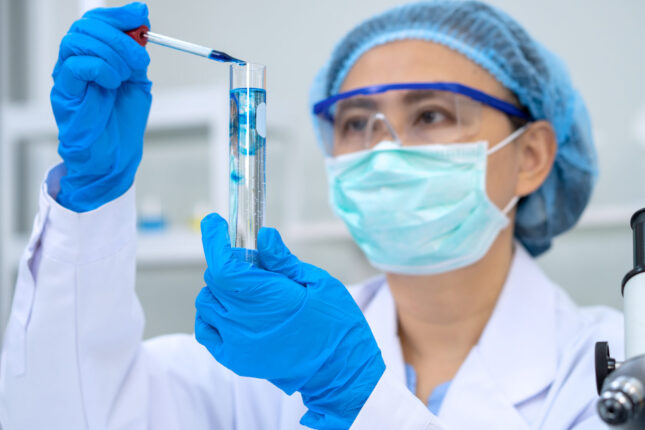
COVID-19 mRNA vaccines and Binocs: 2 years on
With the recent Nobel Prize announcement, the COVID-19 mRNA vaccines are in the news again this week, 2½ years after they were made available to the pandemic-stricken world. In this blog post, Adam Lester-George briefly explains why this novel type of vaccine was so exceptional, how its rapid development and release was unprecedented, and how Bluecrux successfully delivered an ultra fast-tracked implementation of Binocs to assist with planning and scheduling the critical quality control (QC) processes.
In a rush? Here are the 3 key takeaways
- 👉 mRNA vaccines are an entirely novel form of drug product that radically change how vaccinations can inoculate populations without ever exposing developers or patients to the original antigen
- 👉 The SARS-CoV-2 vaccines developed by Pfizer-BioNTech and Moderna were unprecedented in how rapidly they were made commercially available
- 👉 New QC processes needed to be developed to test these novel products and Binocs played a part in supporting the analysis of thousands of samples for billions of doses.

Nobel Prize-winning science
Last week, the winners of the 2023 Nobel Prize in Physiology or Medicine were announced as Drew Weissman and Katalin Karikó for their groundbreaking research into the nucleoside base modifications that enabled the development of effective mRNA vaccines against SARS-CoV-2, the viral agent responsible for the COVID-19 pandemic.
Although a Nobel Prize can only be awarded to a maximum of 3 people, in reality the end products in this case were the result of thousands of dedicated science and logistics professionals who built upon the work of Profs Weissman and Karikó. As we shall see, Binocs played a small but important role in supporting those tireless professionals, assisting with the quality control of billions of mRNA vaccine doses that were manufactured in Belgium and shipped to nations across the globe.
But first, some background.
What are mRNA vaccines?
Vaccination and inoculation
Traditional human vaccines, which were first developed more than 2 centuries ago, function by introducing a relatively safe variant of a pathogen—typically a virus—to a person’s body. This triggers the system’s immune response, causing antibodies to be produced by the white blood cells and resulting in inoculation against the wider family of diseases.
In the most famous early example from the end of the 18th century, English physician, Edward Jenner, used samples of cowpox—a bovine virus with a marginal fatality rate in humans—to inoculate people against the related but far deadlier disease, smallpox. Since then, progressively better smallpox vaccines have resulted in the complete eradication of the virus worldwide.
While generally a low risk procedure, the traditional vaccination approach does depend on identifying and/or manufacturing an attenuated or inactivated version of the pathogen that can be safely administered to humans. However, the virulence and transmissibility of some pathogens is so great that simply handling them presents a significant risk and requires very high biocontainment precautions. This dramatically limits the ease with which the pathogen can be processed in order to produce an effective vaccine.
Genetically activated immune response
On the other hand, if the genetic code of the pathogen can be sequenced, a DNA template can be synthetically produced in a lab using only the genetic data as a starting point, without ever needing to come into direct contact with the disease agent itself.
Today, we understand that the body’s immune system identifies different viruses by recognizing the unique protein structures on the foreign cell’s surface. The exact expression of those structures is encoded in the virus’ messenger RNA (mRNA), a molecule that represents the blueprint for constructing specific proteins.
By identifying the genetic code of a virus’ mRNA, scientists can replicate it and develop a drug product that can be administered to humans. In so doing, this mRNA instructs the body’s own cells to produce the protein in question, allowing the immune system to react and safely begin producing the relevant antibodies.
In this way, people can become inoculated to a disease without ever having been infected with it.
How was the COVID-19 vaccine produced so rapidly?
Development
As soon as the SARS-CoV-2 virus was first identified in late 2019, the Chinese Center for Disease Control and Prevention began sequencing its genetic code. By early January 2020 it had published the entire viral genome, 2 months before the WHO declared a state of global pandemic.
BioNTech, a German biotechnology company who had already been exploring mRNA vaccination methodologies for influenza, had the pre-existing infrastructure to immediately use this genetic information to begin developing potential vaccines.
mRNA vaccine researcher and Nobel laureate, Katalin Karikó, was senior VP at BioNTech at this time. She and co-laureate, Drew Weissman, are joint holders of the US patent for the nucleoside base modification process that renders viral mRNA safe for use in vaccines. This process was licensed to both BioNTech and US RNA therapeutics company, Moderna.
Within several months, BioNTech had entered into partnership with US pharmaceutical giant, Pfizer, to license the industrial production and distribution of the final product. Moderna, in turn, partnered with Swiss CMO, Lonza, to handle their production requirements.
Testing
Over the course of 2020, the two therapy developers each conducted multiple, parallel Phase I-II trials to assess the efficacy of several different variants compared to placebo in double-blind tests.
Eventually, Pfizer-BioNTech identified their most successful variant as BTN162b—what would later be branded as “Comirnaty”—with a effective inoculation rate of ~95%. Moderna’s mRNA-1273 vaccine was selected as their most effective (at ~94%) and would later become known as “Spikevax”.
Production
Incredibly, both partnerships began “at-risk” industrial manufacture of their respective vaccines by mid-2020, months before any regulatory approval had been granted. This was a highly unusual move, since it meant proceeding with costly production, testing, and storage processes despite lacking any guarantee that the products would be authorized and thus that there would be any return on the significant upfront investment.
By the time emergency use authorizations (EUA) were greenlit by regulatory bodies in UK, EU, and US (between 2 Dec 2020 and 8 Jan 2021), less than a year had passed since development work had commenced, and yet a total of 120 million doses had already been manufactured. The first public vaccinations with these products began shortly thereafter, smashing the previous record of 3-4 years from the development to the commercial availability of a new vaccine.
Why was the QC step so critical?
Producing any drug product is a long and complicated process involving many critical steps. Accelerating the journey from development to commercial availability requires more than simply fast-tracking development, manufacturing, and licensing—it is also vital for regulatory approval and patient safety that rigorous quality standards are met.
In the case of these mRNA vaccines, the manufacturing processes and final products contained various novel components that had never before been used, requiring the development of entirely new testing methods. These included using advanced biological, biophysical, and biochemical assays (such as dynamic light scattering, sequencing, and cell-based flow cytometry), as well as novel methods for assessing raw materials and to ensure product consistency across distributed manufacturing networks.
To guarantee manufacturing capacity, both Pfizer-BioNTech and Moderna/Lonza received significant investment to expand the scale of their production and quality control operations, enabling them to accommodate the significant volume of product required to ease the global health crisis.
At the same time, EU and other political blocs implemented “green lanes” to enable international travel by essential workers in spite of the pandemic travel restrictions. This enabled the upscaled vaccine production sites to increase their technical workforce, including QC analysts.
However, having the personnel and equipment available for extensive quality control is not, by itself, sufficient to facilitate rapid product release—those resources must also be effectively managed to ensure optimal performance, especially under in such trying circumstances.
How did Binocs help?
In early January 2021, just as the EUAs were being granted, Bluecrux was approached by one of the primary global sites for manufacturing the final COVID-19 vaccine product as it prepared to ramp-up production to 1bn doses annually. This recently-expanded site in Belgium required a robust system for managing its upscaled QC testing capacity—and it needed it in a hurry: within just 3 weeks!
Ordinarily, our tried-and-tested FastTrack™ methodology allows us to deliver a complete Binocs implementation on-site within 14 weeks; however, life during the pandemic was anything but ordinary! Exceptional times call for exceptional measures.
Despite continued, strict lockdown restrictions in Belgium and Ireland, members of our Binocs squad in both countries immediately prioritized work to deliver a complete lab scheduling system within the requested timeframe. Amazingly, by dedicating their energies to the task, working tirelessly under challenging conditions, and coordinating the entire process remotely, the team was able to deliver the Binocs scheduling and capacity management solution at their QC lab in just 17 days!
Since then, this site has been responsible for producing in excess of a billion doses annually, involving more than 20,000 QC tests planned by Binocs.
In conclusion
Despite the dreadful toll on the global population over the course of the 2020-2022 pandemic, the rapid development and distribution of mRNA vaccines has helped to inoculate hundreds of millions of people worldwide and has been responsible for saving countless lives. We’re delighted to note Weissman and Karikó’s much-deserved recognition by the Norwegian Nobel Committee for their critical role in making this possible!
While COVID-19 remains a public health concern, these prophylactic treatments have had an incalculable impact on society’s ability to return to a normal way of life—and we’re proud to also have played small part in making that a reality.
If you’re interested in seeing how Binocs can help optimize your biopharma QC operations, reach out today for a chat and let’s see where the future takes us!
Let’s talk about QC planning
Adam has two decades of experience working in clinical trials, biomedical research, public health, and health economics, with a particular interest in the intersection between technology and life sciences. For 7 years before joining Bluecrux in 2019, Adam was the director of healthcare innovation consultancy “LeLan” and brings a wide range of insights to his role as Content Specialist for Binocs.



